#Beaked Whales
Explore tagged Tumblr posts
Text
Today, while researching a recently described fossil whale from Peru, I learned that we have fossil remains of a 6 meter long beaked whale from freshwater deposits of Turkana, Kenya, some 600 kilometers from shore.
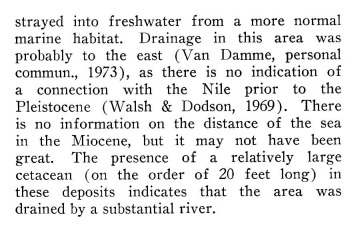
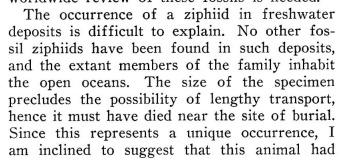
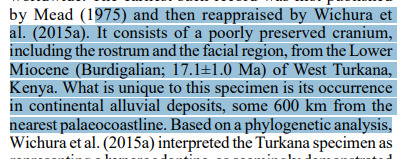
On the one hand that is absolutely mindblowing, given that modern beaked whales are generally open ocean deep divers (tho their ancestors may have been more like dolphins back in the day), to see one that made it this far inland is incredible.
Now cool as the idea of a freshwater beaked whale of that size (or any size really) would be, as the author points out its probably more likely that it swam so far on accident and that this was not its usual habitat.
This wouldn't be without precedent, as there are examples of modern baleen whales randomly popping up far inland even today, like a 5.5 meter long Minke whale being found 1000 km into Amazon in 2007 and another, 4 meter long, Minke whale being discovered 150 km up the Thames in London as recently as 2021.
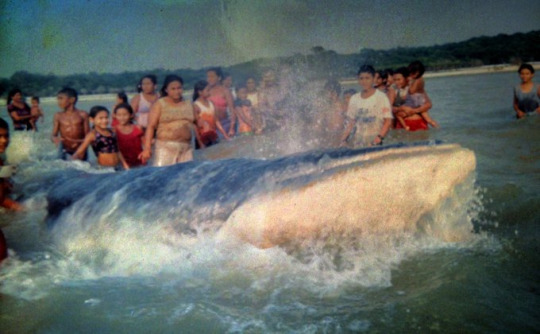

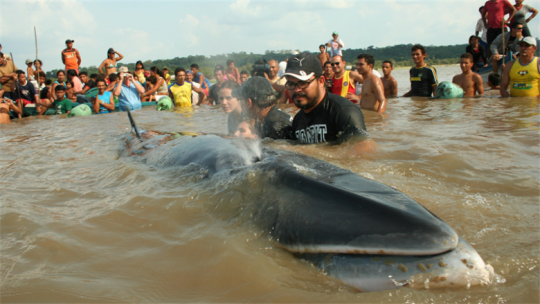
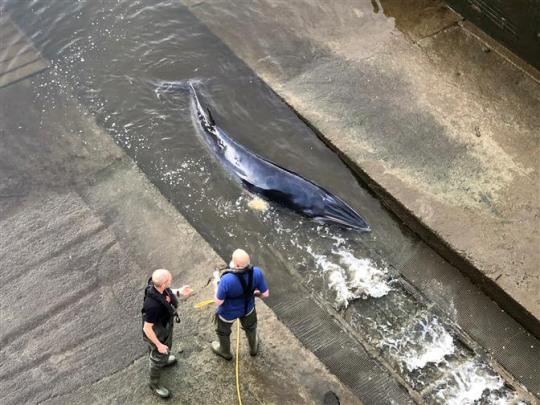
repository.si.edu/bitstream/handle/10088/2649/1975c-file.pdf?sequence=1&isAllowed=y
49 notes
·
View notes
Text
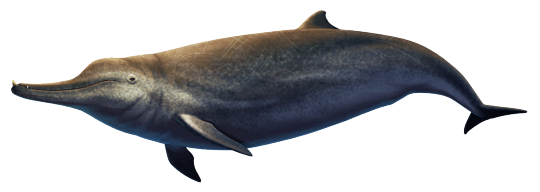
Ninoziphius platyrostris was an early beaked whale that lived during the late Miocene (~6 million years ago) in warm coastal waters covering what is now southwestern Peru. Its ancestors appear to have branched off from all other beaked whales very early in the group's history, indicating a "ghost lineage" going back to at least 17 million years ago.
About 4.4m long (~14'5"), it was less specialized for suction feeding and deep diving than modern beaked whales. Also unlike most modern species its jaws were lined with numerous interlocking teeth, with heavy wear suggesting it may have hunted close to the seafloor, where disturbed sand and grit would have regularly ended up in its mouth along with its prey and steadily ground down its teeth during its lifetime.
Males had a pair of stout tusks at the tip of their upward-curving lower jaw, with possibly a second smaller set of tusks behind them, which were probably used for fighting each other like in modern beaked whales.
Its shallow water habitat and more abrasive diet suggest Ninoziphius' lifestyle was much more like modern dolphins than modern beaked whales, and other early beaked whales like Messapicetus similarly seem to have occupied dolphin-like ecological niches.
These dolphin-like forms disappeared around the same time that true dolphins began to diversify, possibly struggling to compete for the same food sources, while other beaked whales that had begun to specialize for deep sea diving survived and thrived. Interestingly this ecological shift seems to have happened twice, in two separate beaked whale lineages – although only one of them still survives today – with bizarre bony "internal antlers" even independently evolving in both groups.
———
NixIllustration.com | Tumblr | Patreon
References:
Bianucci, Giovanni, et al. "New beaked whales from the late Miocene of Peru and evidence for convergent evolution in stem and crown Ziphiidae (Cetacea, Odontoceti)." PeerJ 4 (2016): e2479. https://doi.org/10.7717/peerj.2479
Bianucci, Giovanni, et al. A new Late Miocene beaked whale (Cetacea, Odontoceti) from the Pisco Formation, and a revised age for the fossil Ziphiidae of Peru. Bollettino della Societa Paleontologica Italiana 63.1 (2024): 21-43. https://www.researchgate.net/publication/380459192_A_new_Late_Miocene_beaked_whale_Cetacea_Odontoceti_from_the_Pisco_Formation_and_a_revised_age_for_the_fossil_Ziphiidae_of_Peru
Gol'din, Pavel. "‘Antlers inside’: are the skull structures of beaked whales (Cetacea: Ziphiidae) used for echoic imaging and visual display?." Biological Journal of the Linnean Society 113.2 (2014): 510-515. https://doi.org/10.1111/bij.12337
Lambert, Olivier, Christian De Muizon, and Giovanni Bianucci. "The most basal beaked whale Ninoziphius platyrostris Muizon, 1983: clues on the evolutionary history of the family Ziphiidae (Cetacea: Odontoceti)." Zoological Journal of the Linnean Society 167.4 (2013): 569-598. https://doi.org/10.1111/zoj.12018
Lambert, Olivier, et al. "No deep diving: evidence of predation on epipelagic fish for a stem beaked whale from the Late Miocene of Peru." Proceedings of the Royal Society B: Biological Sciences 282.1815 (2015): 20151530. https://doi.org/10.1098/rspb.2015.1530
#science illustration#paleontology#paleoart#palaeoblr#ninoziphius#ziphiidae#beaked whale#odontoceti#toothed whale#cetacean#whale#artiodactyla#ungulate#mammal#art
262 notes
·
View notes
Text
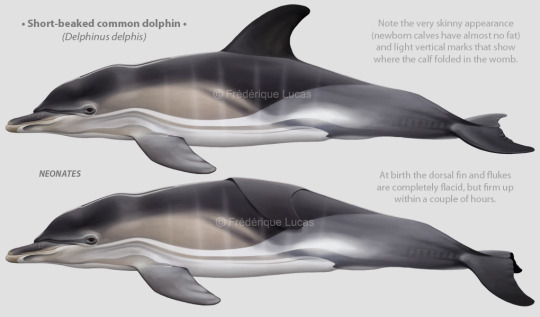
And here's the finished babu! This illustration - another one for SECAC - took by far the longest as its the only one requested at high detail. The commissioner wanted all the details of a true newborn to be visible.
The most special might be the vibrissae, or whiskers, visible on the rostrum. While some cetaceans retain whiskers into adulthood (baleen whales and river dolphins having quite a good covering), most oceanic dolphins are hairless as adults. However at birth they all show their mammalhood in the form of a couple of whiskers. How long they keep them depends, some babies lose them within hours, others keep them for a few days.
Another sign of a very "fresh" baby is the floppy dorsal fin and flukes. These are entirely made of cartilage, and are completely soft during gestation and birth. The dorsal fin usually hardens first, followed by the flukes. Note also the peanut head - normally a sign of extreme emaciation in adult cetaceans, for newborns it is normal. Soon their mother's rich milk grants them a healthy layer of baby fat, turning them into the round adorable calves many are perhaps more familiar with.
#illustrations#Short-beaked common dolphin#Delphinus delphis#Common dolphin#Delphinus#calf#baby#neonate#whiskers#toothed whale#cetacean#digital art#scientific illustration
58 notes
·
View notes
Text
I know other people have mentioned that Melville would've gone crazy if 19th century sailors knew how sperm whales sleep, but I think he'd also go crazy over the confirmation that some of their scarring comes from being one of only two natural predators of adult giant squid, the arms/tentacles of which are covered in serrated barbs and harpoon-like hooks.
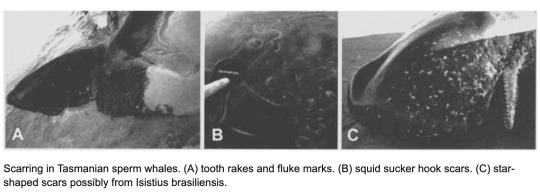
#sperm whale stomachs have also been found chock full of indigestible squid beaks#which whalers either wouldn't have seen or would've been unable to parse since it looks like literal pounds of alien shrapnel#pictures.blueplanetarchive.com/image/I0000BNGDpHAsbJI#<- peep the beaks#animalia#moby dick#or the whale#EDITED PER AN: some squid detritus is found in the ambergris!
116 notes
·
View notes
Text
Wet Beast Wednesday: Cuvier's beaked whale
Today's Wet Beast Wednesday post is going to be a deeper dive than usual, because this week's post is about the deepest-diving whale. Beaked whales are an elusive and poorly-understood family known for diving to extreme depths. Of the 24 known species, Cuvier's beaked whale is the most well-known. Dive in (get it?) to learn about this cryptic cetacean.
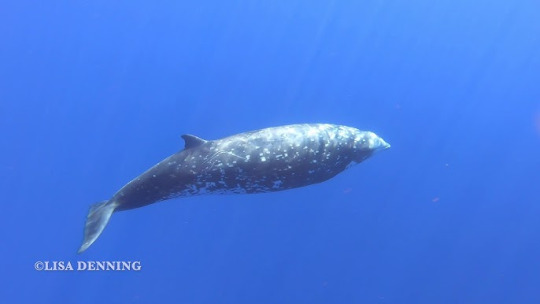
(Image: a Cuvier's beaked whale underwater. It is a small whale similar in appearance to a bottlenose dolphin, though stockier and with a shorter snout. The dorsal fin is far back on the body Its body is gray and covered in white, circular scars, likely bites from cookie cutter sharks. End ID)
Beaked whales are poorly-studied because of their remote habitats and tendency to spend more time underwater than other whales. It is also often hard to distinguish between different species without a close examination. The name comes from their skulls, which are notably toothless and elongated around the mouth, making them look like they have beaks. Beaked whales only have one pair of teeth and they only grow out in males. Female beaked whale teeth remain in the gums and never grow. Cuvier's beaked whale (Ziphius cavirostris), sometimes called the goose-beaked whale, is large for a beaked whale, with the larger males maxing out at 7 meters (23 ft) and 3.5 tons. They resemble dolphins in body shape, but with robust and stocky bodies. Their bodies are gray to light brown while the heads are lighter in color, especially in males. The melon is relatively small and the mouth is shorter than in most beaked whales, making it easier to differentiate them. The melon is an organ found in toothed whales that aids in echolocation.
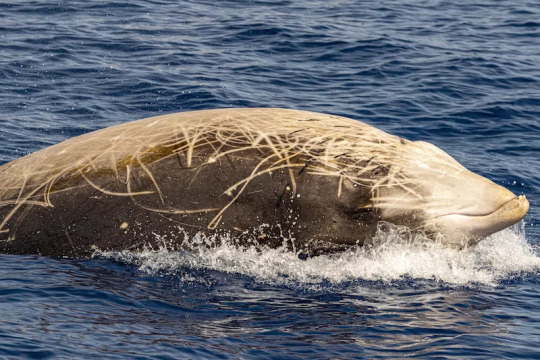
(image: a beaked whale peaking its head out of the water. It is likely a male due to its white face. Its back is densely covered in long, whit scars. End ID)
Beaked whales have multiple adaptations to deep diving. During dives, the heart rate decreases and blood flow is redirected to more important organs and tissues. The lungs collapse, leaving oxygen storage to the hemoglobin in the blood and myoglobin in the muscles. Long periods of time without breathing results in the buildup of lactic acid in the blood, which can be toxic. Beaked whales have enlarged spleens and livers that may help filter lactic acid out of the blood. Their bodies are very streamlined and the flippers can be held very tightly against the body to reduce drag. There are likely other adaptations for very deep and very long dives that have not been studied.
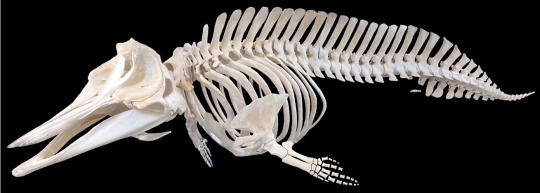
(Image: the skeleton of a Cuvier's beaked whale. It is somewhat short for a whale, with small flippers. The skull is long and flat. End ID)
Cuvier's beaked whale is the most widely-distributed beaked whale, being found worldwide in tropical to temperate waters. They prefer to swim in very deep water and are rarely seen near shore. Cuvier's beaked whale holds the record for the deepest and longest dive of any marine mammal. The records (recorded by satellite tags) for depth was a dive to 2,992 m (9,816 ft) and for length was a 222 minute (about 3.75 hours) dive. The whales will usually make multiple shallower dives to around 500 m (1,640 ft) between each deep dive, possibly to give their bodies time to recover while still searching for food. They spend very little time at the surface between dives, usually no more than 8 minutes. These short surface intervals may be to avoid predators like orcas. Occasionally, longer surface intervals of several hours have been observed. Their hunting behavior changes depending on how deep they dive. On shallower dives, they remain silent, possibly to avoid being overheard by predators, while on deep dives, they use echolocation to find prey in the darkness of the deep ocean. Cuvier's beak whale hunts via suction. They open their mouths while retracting the tongue and enlarging the throat to create a vacuum that sucks prey into their mouths, which is then swallowed whole. Dissections have revealed that squid make up over 80% of their diet. The whales forage in small pods that coordinate their dives and hunting strategy. It has been speculated that the teeth of males are used to fight over access to females. Males have been found with scars that would seem to fit being raked with another male's teeth. Males also generally have more scars than females, which would be consistent with them fighting each other. Almost nothing is known about beaked whale reproduction, though calves do live with their mothers as in other whales.

(Image: a Cuvier's beaked whale jumping out of the water. End ID)
Little is known about the conservation needs of Cuvier's beaked whale. They are likely the most abundant species of beaked whale due to their wide distribution. They are known to be threatened by entanglements in fishing nets and have been harvested by whalers in the past. They may be targeted by the Japanese whaling industry, but it is difficult to be sure due to the secrecy of said industry. Cuvier's beaked whale is known to be vulnerable to sonar, especially mid-range sonar. They have been observed avoiding areas where sonar is used and use of sonar has been correlated to mass strandings and symptoms of decompression sickness (the bends). It is possible that the sonar drives them to ascend from dives too quickly, leading to potentially fatal gas embolisms. Notably, several mass strandings happened in the Canary Islands while naval exercises were performed there. Once those exercises stopped, the mass strandings stopped as well. Cuvier's beaked whale was described and named by naturalist, zoologist, paleontologist, and virulent racist and misogynist Georges Cuvier, who described it using a skull he thought was a fossil. There has been a small push recently to begin using the name goose-beaked whale instead to keep from honoring him.

(Image: a Cuvier's beaked whale poking its head out of the water. Its body is light gray, with a few scars. End ID)
#wet beast wednesday#whale wednesday#cuvier's beaked whale#goose-beaked whale#beaked whale#whale#whales#cetacean#toothed whale#marine mammals#marine biology#biology#ecology#zoology#animal facts#informative#educational#image described
50 notes
·
View notes
Text

Arnoux's beaked whale Berardius arnuxii
Observed by justinhofman13, CC BY-NC
#Berardius arnuxii#Arnoux's beaked whale#Cetacea#Ziphiidae#cetacean#whale#Antarctica#Southern Ocean#Gerlache Strait#snow#sea ice
43 notes
·
View notes
Text
Sometimes I look up animals to reference for my critters. And sometimes I get terrified and have to take a mental breather before braving the wilds again for good critter design.
#It is pain but anything for good design#It's usually sea animals for some reason#Greenland sharks are terrifying to me for no reason#Also beaked whales are so scary they just chilling and I get spooked#Kos speaks
72 notes
·
View notes
Text
🐋Daily Cetacean Fact:🐋
Cuvier's Beaked Whale: Cuvier’s beaked whales are capable of diving up to at least 3,300 feet for 20 to 40 minutes to opportunistically feed on mostly cephalopods and sometimes fish and crustaceans. A pair of ventral throat grooves help to create a vacuum within their mouths, allowing the whales to suck in their targeted prey. The deepest known dive for a Cuvier’s beaked whale was 9,816 feet (nearly 2 miles) and the longest known dive lasted 222 minutes (3.7 hours)!
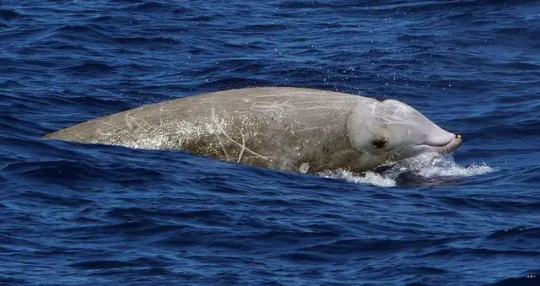
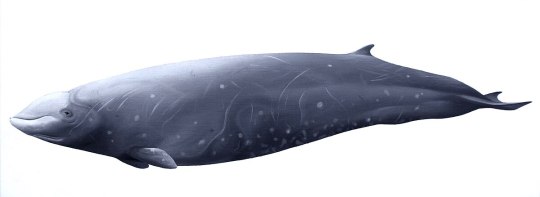
#cuvier's beaked whale#beaked whale#whale#whale post#whale fact#daily whale fact#daily whale#cetacean facts#cetacean post#daily ceteacean#daily cetacean fact#facts about cetaceans#facts about whales#respect the locals#marine life blog#marine mammals#marine animals#marine biology#marine life#marine#ocean animal#ocean life#ocean#advocacy for marine life
52 notes
·
View notes
Text
#2487 - Mesoplodon layardii - Strap-toothed Beaked Whale
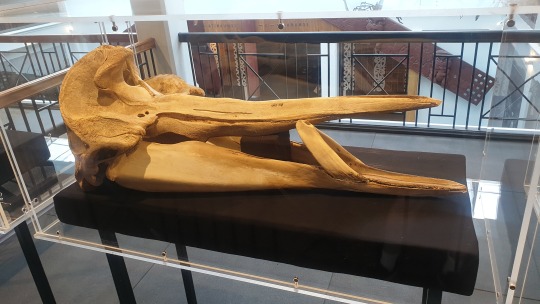
Named after the bizarre teeth, and Edgar Leopold Layard, the curator of the South African Museum, who sent drawings of a skull to the British taxonomist John Edward Gray, who described the species in 1865.
Largest of the Mesoplodons, growing to 6.2m in length, despite the fact that the strap-like tusks stop them opening their jaws more than 3cm. At least the females aren't so encumbered. It seems certain the teeth are used in male-male combat, but the only actual damage comes from a small spike on the tip of the teeth.
Sporadic strandings and sightings suggest the whale is widespread in the Southern Ocean, although one individual did show up in Myanmar in 2011.
Mostly a squid-feeder, caught by suction feeding. Hunted by orca, and harmed by sonar.
Whanganui Regional Museum, New Zealand
#mesoplodon#ziphiidae#beaked whale#strap-toothed beaked whale#tw: dead animal#cetacean#strap-toothed whale
48 notes
·
View notes
Text

Happy Valentine's Day, folks!
#drawing#animal art#procreate#nature art#wildlife art#marine art#nature#valentines day#loveart#whales#beaked whale#straptoothedwhale#heart art
13 notes
·
View notes
Text
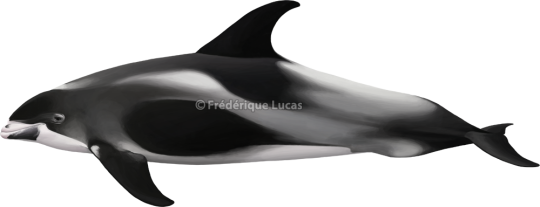
White-beaked dolphin (Lagenorhynchus albirostris) My friends! Behold! A new friend!!! After more than a year (no joke) without a proper commission, I had a lovely new project to work on these past weeks.
It's for Mindfully Wired Communications, a company in the UK that translates scientific information to the general public through all sorts of means. They're currently collaborating on a project to reduce bycatch in UK fisheries, and part of that is creating an ID guide for the fishermen of animals they might encounter at sea. Really important work which I'm happy to contribute to.
Most of the illustrations they needed I already had lying around. But a few had to be made anew, one of which this handsome fellow, the White-beaked dolphin! Markings wise, they are one of my favourite species of dolphin. I love the way everything on their body just flows. Also they have great whopping dorsal- and pectoral fins, and, irony of ironies, often black-marked beaks as adults.
For some reason it was quite a struggle to make him look right, but in the end I'm happy with the result. I hope you like it too, and the other friends will follow soon!
#illustrations#scientific illustration#White-beaked dolphin#dolphin#Lagenorhynchus albirostris#Lagenorhynchus#toothed whale#cetacean
67 notes
·
View notes
Text
#good news#environmentalism#science#environment#nature#animals#conservation#antarctica#whales#Arnoux's beaked whale#marine life#marine animals#marine mammals#marine biology#oceanography
35 notes
·
View notes
Text
new whale just dropped

#going to piggyback of my shark post to become the purveyor of marine news#despite my phobia of fish#this is cool though we’ve literally only had skeletons before#we’re going to learn so much!!!#whale#beaked whale#marine life#endangered
17 notes
·
View notes
Text
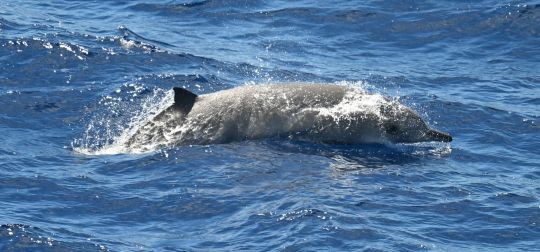
Gray's beaked whale Mesoplodon grayi
Observed by afahawkins, CC BY-NC
29 notes
·
View notes
Text
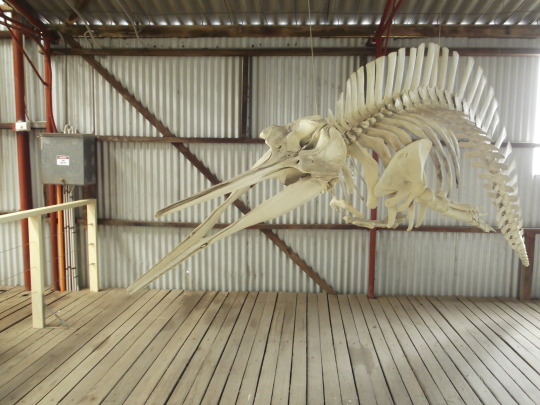

#from a few weeks ago#skeleton#gray's beaked whale#false killer whale#skeletons#myphoto#whale#cetacean
7 notes
·
View notes
Text


#polls#animal polls#cetacea tournament#australian snubfin dolphin#baird's beaked whale#dolphin#whale
5 notes
·
View notes